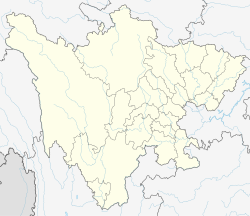1955 Zheduotang earthquake
| UTCtime | 1955-04-14 01:29:04 |
|---|---|
| ISCevent | 889422 |
| USGS-ANSS | ComCat |
| Local date | April 14, 1955 |
| Local time | 09:29:02CST |
| Magnitude | 7.0 Mw 7.1Ms |
| Depth | 10 km |
| Epicenter | 29°57′25″N101°45′32″E/ 29.957°N 101.759°E |
| Fault | Xianshuihe fault system |
| Type | Strike-slip |
| Areas affected | Sichuan, China |
| Max.intensity | MMI IX (Violent) CSIS X |
| Landslides | Yes |
| Casualties | 70 dead |
The1955 Zheduotang earthquake,also known as theKangding earthquakeoccurred on April 14 at 09:29:02local timenear the city ofKangdingin theGarzê Tibetan Autonomous Prefecture,Sichuan.The earthquake had a moment magnitude of 7.0 and a surface wave magnitude of 7.1 and struck at a depth of 10 km.[1]Severe damage occurred in Kangding with the loss of 70 lives.
Tectonic setting[edit]
WesternSichuanis situated at the edge of theTibetan Plateauin a vast zone of complex continental deformation caused by thecollisionof theIndian Platewith theEurasian Plate.As the thrusting of the Indian Plate beneath the Eurasian Plate along theHimalayascontinues, the continental crust within the Eurasian Plate is actively uplifted and thickened, forming the Tibetan Plateau. As there are no active thrust structures within the plateau, compression is accommodated bystrike-slipmotion along large structures including theAltyn Tagh Fault,Kunlun Fault,Haiyuan FaultandXianshuihe fault system.Left-lateralstrike-slipmotion squeezes the crustal blocks of the Tibetan Plateau outwards, forcing it to move eastwards. Meanwhile, the strike-slip motion also results in east-westextensionof the plateau, causingnormal faultsto break within the thickened crust.[2][3]
TheXianshuihe fault systemis a 1,400-km-long active left-lateralstrike-slipfault that accommodate the strike-slip motion in the Tibetan Plateau. The fault is one of the largest active intracontinental geological structure in the world. Beginning in 1893, at least 350 km of the fault length has ruptured in large successive earthquakes with magnitudes 6.5 or larger.[4]Going back to the year 1700 to present-day, the fault has ruptured its entire 1,400 km length during large earthquakes.[5]
Earthquake[edit]
The earthquake specifically ruptured the Zheduotang Fault; a segment of the Xianshuihe fault system. The left-lateralstrike-sliprupture mechanism is consistent with movement along the fault system. A 43-km-longsurface ruptureis associated with the mainshock. In a November 2020 study published in the academic journalGeological Journal,themoment magnitudeof the mainshock was evaluated at 7.0 Mw . Previous studies have placed the surface wave and moment magnitudes at 7.5.[6]
Coulomb stress transferafter the 1955 earthquake increased seismic strain on the adjacent Selaha Fault, also part of the Xianshuihe fault system. In 2014,an earthquakemeasuring magnitudes 5.9 ruptured the Selaha Fault, releasing some of the strain.[7]Since the 1955 quake, the Zheduotang Fault has accumulated enough strain to generate a magnitude 6.5–6.8 earthquake with the potential to cause severe destruction.[8]
Damage[edit]
Manylandslideswere triggered and the groundfissured.Natural springs erupted water intensely or dried up. Spring water discolored after the quake. A total of 624 homes and temples were destroyed and 1,083 were damaged in Kangding. At least 70 people died and 217 were injured.[9]Walls around the city toppled. Approximately 90% of the city's wooden-frame or adobe-constructed structures were destroyed. There were more than 30 landslides recorded, many of which blocked roads. InLuding County,shabby homes collapsed. Bridges, dams and ravines were seriously damaged or collapsed.[10]Landslides affected an area of 4,416 km2.[11]
See also[edit]
References[edit]
- ^"M 7.1 - 19 km WSW of Kangding, China".earthquake.usgs.gov.U.S. Geological Survey.Retrieved5 December2021.
- ^Elliott, J. R.; Walters, R. J.; England, P. C.; Jackson, J. A.; Li, Z.; Parsons, B. (2010)."Extension on the Tibetan plateau: recent normal faulting measured by InSAR and body wave seismology".Geophysical Journal International.183(2): 503–535.Bibcode:2010GeoJI.183..503E.doi:10.1111/j.1365-246X.2010.04754.x.S2CID134590278.
- ^Weijun Gan; Peizhen Zhang; Zheng-Kang Shen; Zhijun Niu; Min Wang; Yongge Wan; Demin Zhou; Jia Cheng (2007)."Present-day crustal motion within the Tibetan Plateau inferred from GPS measurements".Journal of Geophysical Research: Solid Earth.112(B8). American Geophysical Union.Bibcode:2007JGRB..112.8416G.doi:10.1029/2005JB004120.
- ^Eleftheria Papadimitriou; Xueze Wen; Vassilios Karakostas; Xueshen Jin (2004). "Earthquake Triggering along the Xianshuihe Fault Zone of Western Sichuan, China".Pure and Applied Geophysics.161(8): 1683–1707.Bibcode:2004PApGe.161.1683P.doi:10.1007/s00024-003-2471-4.S2CID129325246.
- ^Mingkun Bai; Marie-Luce Chevalier; Jiawei Pan; Anne Replumaz; Philippe Hervé Leloup; Marianne Métois; Haibing Li (2018). "Southeastward increase of the late Quaternary slip-rate of the Xianshuihe fault, eastern Tibet. Geodynamic and seismic hazard implications".Earth and Planetary Science Letters.485:19–31.Bibcode:2018E&PSL.485...19B.doi:10.1016/j.epsl.2017.12.045.
- ^Bing Yan; Maomao Wang; Dong Jia; Jian Cui (2020)."Investigation and magnitude re-evaluation of the 1955 Zheduotang earthquake, eastern Tibetan Plateau, China".Geological Journal.55(11, Special Issue: Neotectonics: Active Tectonics and Paleo‐environmental Change in Western China). Wiley Online Library: 7272–7284.doi:10.1002/gj.3628.S2CID202921614.
- ^Bing Yan; Shinji Toda; Aiming Lin (2018)."Coulomb Stress Evolution History as Implication on the Pattern of Strong Earthquakes along the Xianshuihe-Xiao gian g Fault System, China".Journal of Earth Science.29(2): 427–440.Bibcode:2018JEaSc..29..427Y.doi:10.1007/s12583-018-0840-2.ISSN1674-487X.S2CID134947507.
- ^Marie-Luce Chevalier; Mingkun Bai; Shiguang Wang; Jiawei Pan; Philippe Hervé Leloup; Anne Replumaz; Kaiyu Li; Qiong Wu; Fucai Liu; Haibing Li; Jin gian g Zhang (2021)."Late Quaternary slip-rates along the Moxi and Zheduotang segments of the SE Xianshuihe fault, eastern Tibet, and geodynamic implications"(PDF).Ess Open Archive ePrints.105.ESSOAr.Bibcode:2021esoar.10505744C.doi:10.1002/essoar.10505744.1.S2CID234134468.
- ^"Đại tai vô tình! Kiểm kê trong lịch sử Tứ Xuyên phát sinh 10 dư thứ 7 cấp trở lên động đất"[The catastrophe is merciless! Inventory of more than 10 earthquakes of magnitude 7 and above that occurred in Sichuan in history].chengdumingxiao(in Chinese). 10 August 2017.Retrieved5 December2021.
- ^"Significant Earthquake Information".ngdc.noaa.gov.NOAA National Centers for Environmental Information.Retrieved5 December2021.
- ^X. L. Chen; Q. Zhou; H. Ran; R. Dong (2012)."Earthquake-triggered landslides in southwest China".Natural Hazards and Earth System Sciences.12(2): 351–363.Bibcode:2012NHESS..12..351C.CiteSeerX10.1.1.838.9836.doi:10.5194/nhess-12-351-2012.
External links[edit]
- TheInternational Seismological Centrehas abibliographyand/orauthoritative datafor this event.

